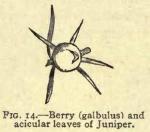23. Juniperus, N.F.—Juniper Berries.
 23. JUNIPERUS, N.F.—JUNIPER BERRIES. The fruit of Junip'erus commu'nis Linné, an evergreen shrub or small tree inhabiting the Northern Hemisphere, bearing small cones, the scales of which coalesce in threes, become fleshy, and ripen into the so-called berry. These berries or fruits are globular, about the size of a large pea, with a triangular depression at the top caused by a three-rayed furrow where the scales are united; at the base are a few small scales, remnants of undeveloped whorls; externally of a glossy, purplishblack color, covered with a grayish bloom; they contain a brownish-yellow pulp with oil-glands, in which are imbedded three small, bony, angular seeds, also covered with large oil-glands; odor disagreeably aromatic, balsamic; taste sweetish, warm, and balsamic, slightly bitter. The Smyrna berry from J. phoenicea Linné, yields an oil of greater optical activity.
23. JUNIPERUS, N.F.—JUNIPER BERRIES. The fruit of Junip'erus commu'nis Linné, an evergreen shrub or small tree inhabiting the Northern Hemisphere, bearing small cones, the scales of which coalesce in threes, become fleshy, and ripen into the so-called berry. These berries or fruits are globular, about the size of a large pea, with a triangular depression at the top caused by a three-rayed furrow where the scales are united; at the base are a few small scales, remnants of undeveloped whorls; externally of a glossy, purplishblack color, covered with a grayish bloom; they contain a brownish-yellow pulp with oil-glands, in which are imbedded three small, bony, angular seeds, also covered with large oil-glands; odor disagreeably aromatic, balsamic; taste sweetish, warm, and balsamic, slightly bitter. The Smyrna berry from J. phoenicea Linné, yields an oil of greater optical activity.
CONSTITUENTS.—Volatile oil, most abundant in the full-grown green berries, being partially converted into resins on ripening, entirely so in the dead-ripe, black berries; also juniperin, sugar (15 to 30 per cent.), wax, fat, proteids, mucilage, etc. Their virtues are extracted by water and alcohol.
ACTION AND USES.—Stimulant and diuretic, chiefly used as an adjuvant to more powerful diuretics in dropsical complaints. Dose: 15 to 60 gr. (1 to 4 Gm.), in infusion, water spirit, etc., the volatile oil, however, obtained from the wood and branches, being principally used. They are largely used in the manufacture of gin, which owes its diuretic properties to them.
23a. OLEUM JUNIPERI, U.S.—OIL OF JUNIPER. A colorless or greenish-yellow volatile oil, with a strong, terebinthinate odor and a hot, acrid taste. Specific gravity 0.850 to 0.865. It consists of pinene, C10H16, cadinene, and juniper camphor.
- OFFICIAL PREPARATIONS.
- Spiritus Juniperi (5 per cent.), Dose: 30 drops (2 mils).
- Spiritus Juniperi Co. (0.4 per cent.), Dose: 2 fldr. (8 mils).

